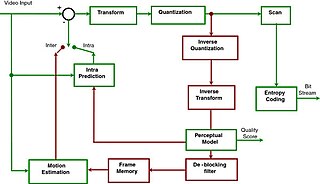In information theory, data compression, source coding, or bit-rate reduction is the process of encoding information using fewer bits than the original representation. Any particular compression is either lossy or lossless. Lossless compression reduces bits by identifying and eliminating statistical redundancy. No information is lost in lossless compression. Lossy compression reduces bits by removing unnecessary or less important information. Typically, a device that performs data compression is referred to as an encoder, and one that performs the reversal of the process (decompression) as a decoder.

In information technology, lossy compression or irreversible compression is the class of data compression methods that uses inexact approximations and partial data discarding to represent the content. These techniques are used to reduce data size for storing, handling, and transmitting content. Higher degrees of approximation create coarser images as more details are removed. This is opposed to lossless data compression which does not degrade the data. The amount of data reduction possible using lossy compression is much higher than using lossless techniques.
Lossless compression is a class of data compression that allows the original data to be perfectly reconstructed from the compressed data with no loss of information. Lossless compression is possible because most real-world data exhibits statistical redundancy. By contrast, lossy compression permits reconstruction only of an approximation of the original data, though usually with greatly improved compression rates.

A video codec is software or hardware that compresses and decompresses digital video. In the context of video compression, codec is a portmanteau of encoder and decoder, while a device that only compresses is typically called an encoder, and one that only decompresses is a decoder.

Arithmetic coding (AC) is a form of entropy encoding used in lossless data compression. Normally, a string of characters is represented using a fixed number of bits per character, as in the ASCII code. When a string is converted to arithmetic encoding, frequently used characters will be stored with fewer bits and not-so-frequently occurring characters will be stored with more bits, resulting in fewer bits used in total. Arithmetic coding differs from other forms of entropy encoding, such as Huffman coding, in that rather than separating the input into component symbols and replacing each with a code, arithmetic coding encodes the entire message into a single number, an arbitrary-precision fraction q, where 0.0 ≤ q < 1.0. It represents the current information as a range, defined by two numbers. A recent family of entropy coders called asymmetric numeral systems allows for faster implementations thanks to directly operating on a single natural number representing the current information.

JPEG 2000 (JP2) is an image compression standard and coding system. It was developed from 1997 to 2000 by a Joint Photographic Experts Group committee chaired by Touradj Ebrahimi, with the intention of superseding their original JPEG standard, which is based on a discrete cosine transform (DCT), with a newly designed, wavelet-based method. The standardized filename extension is .jp2 for ISO/IEC 15444-1 conforming files and .jpx for the extended part-2 specifications, published as ISO/IEC 15444-2. The MIME types for JPEG 2000 are defined in RFC 3745. The MIME type for JPEG 2000 is image/jp2.
Lempel–Ziv–Welch (LZW) is a universal lossless data compression algorithm created by Abraham Lempel, Jacob Ziv, and Terry Welch. It was published by Welch in 1984 as an improved implementation of the LZ78 algorithm published by Lempel and Ziv in 1978. The algorithm is simple to implement and has the potential for very high throughput in hardware implementations. It is the algorithm of the Unix file compression utility compress and is used in the GIF image format.

Advanced Video Coding (AVC), also referred to as H.264 or MPEG-4 Part 10, is a video compression standard based on block-oriented, motion-compensated coding. It is by far the most commonly used format for the recording, compression, and distribution of video content, used by 91% of video industry developers as of September 2019. It supports a maximum resolution of 8K UHD.
JBIG2 is an image compression standard for bi-level images, developed by the Joint Bi-level Image Experts Group. It is suitable for both lossless and lossy compression. According to a press release from the Group, in its lossless mode JBIG2 typically generates files 3–5 times smaller than Fax Group 4 and 2–4 times smaller than JBIG, the previous bi-level compression standard released by the Group. JBIG2 was published in 2000 as the international standard ITU T.88, and in 2001 as ISO/IEC 14492.
Α video codec is software or a device that provides encoding and decoding for digital video, and which may or may not include the use of video compression and/or decompression. Most codecs are typically implementations of video coding formats.
Lossless JPEG is a 1993 addition to JPEG standard by the Joint Photographic Experts Group to enable lossless compression. However, the term may also be used to refer to all lossless compression schemes developed by the group, including JPEG 2000, JPEG-LS, and JPEG XL.
Context-adaptive variable-length coding (CAVLC) is a form of entropy coding used in H.264/MPEG-4 AVC video encoding. It is an inherently lossless compression technique, like almost all entropy-coders. In H.264/MPEG-4 AVC, it is used to encode residual, zig-zag order, blocks of transform coefficients. It is an alternative to context-adaptive binary arithmetic coding (CABAC). CAVLC requires considerably less processing to decode than CABAC, although it does not compress the data quite as effectively. CAVLC is supported in all H.264 profiles, unlike CABAC which is not supported in Baseline and Extended profiles.
Video Acceleration API (VA-API) is an open source application programming interface that allows applications such as VLC media player or GStreamer to use hardware video acceleration capabilities, usually provided by the graphics processing unit (GPU). It is implemented by the free and open-source library libva, combined with a hardware-specific driver, usually provided together with the GPU driver.
High Efficiency Video Coding (HEVC), also known as H.265 and MPEG-H Part 2, is a video compression standard designed as part of the MPEG-H project as a successor to the widely used Advanced Video Coding. In comparison to AVC, HEVC offers from 25% to 50% better data compression at the same level of video quality, or substantially improved video quality at the same bit rate. It supports resolutions up to 8192×4320, including 8K UHD, and unlike the primarily 8-bit AVC, HEVC's higher fidelity Main 10 profile has been incorporated into nearly all supporting hardware.
A video coding format is a content representation format of digital video content, such as in a data file or bitstream. It typically uses a standardized video compression algorithm, most commonly based on discrete cosine transform (DCT) coding and motion compensation. A computer software or hardware component that compresses or decompresses a specific video coding format is a video codec.
The YCoCg color model, also known as the YCgCo color model, is the color space formed from a simple transformation of an associated RGB color space into a luma value and two chroma values called chrominance green (Cg) and chrominance orange (Co). It is supported in video and image compression designs such as H.264/MPEG-4 AVC, HEVC, VVC, JPEG XR, and Dirac. It is simple to compute, has good transform coding gain, and can be losslessly converted to and from RGB with fewer bits than are needed with other color models. A reversible scaled version with even lower bit depth, YCoCg-R, is also supported in most of these designs and is also used in Display Stream Compression. The more complete definition with variable bit depths of Y and chrominance values is given in ITU-T H.273.

AOMedia Video 1 (AV1) is an open, royalty-free video coding format initially designed for video transmissions over the Internet. It was developed as a successor to VP9 by the Alliance for Open Media (AOMedia), a consortium founded in 2015 that includes semiconductor firms, video on demand providers, video content producers, software development companies and web browser vendors. The AV1 bitstream specification includes a reference video codec. In 2018, Facebook conducted testing that approximated real-world conditions, and the AV1 reference encoder achieved 34%, 46.2%, and 50.3% higher data compression than libvpx-vp9, x264 High profile, and x264 Main profile respectively.
Asymmetric numeral systems (ANS) is a family of entropy encoding methods introduced by Jarosław (Jarek) Duda from Jagiellonian University, used in data compression since 2014 due to improved performance compared to previous methods. ANS combines the compression ratio of arithmetic coding, with a processing cost similar to that of Huffman coding. In the tabled ANS (tANS) variant, this is achieved by constructing a finite-state machine to operate on a large alphabet without using multiplication.
JPEG XS is an interoperable, visually lossless, low-latency and lightweight image and video coding system used in professional applications. Target applications of the standard include streaming high-quality content for professional video over IP in broadcast and other applications, virtual reality, drones, autonomous vehicles using cameras, gaming. Although there is not an official acronym definition, XS was chosen to highlight the extra small and extra speed characteristics of the codec.






